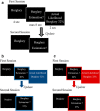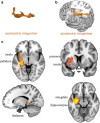Human Frontal-Subcortical Circuit and Asymmetric Belief Updating
- PMID: 26490851
- PMCID: PMC4683678
- DOI: 10.1523/JNEUROSCI.1120-15.2015
Human Frontal-Subcortical Circuit and Asymmetric Belief Updating
Abstract
How humans integrate information to form beliefs about reality is a question that has engaged scientists for centuries, yet the biological system supporting this process is not well understood. One of the most salient attributes of information is valence. Whether a piece of news is good or bad is critical in determining whether it will alter our beliefs. Here, we reveal a frontal-subcortical circuit in the left hemisphere that is simultaneously associated with enhanced integration of favorable information into beliefs and impaired integration of unfavorable information. Specifically, for favorable information, stronger white matter connectivity within this system, particularly between the left inferior frontal gyrus (IFG) and left subcortical regions (including the amygdala, hippocampus, thalamus, putamen, and pallidum), as well as insular cortex, is associated with greater change in belief. However, for unfavorable information, stronger connectivity within this system, particularly between the left IFG and left pallidum, putamen, and insular cortex, is associated with reduced change in beliefs. These novel results are consistent with models suggesting that partially separable processes govern learning from favorable and unfavorable information.
Significance statement: Beliefs of what may happen in the future are important, because they guide decisions and actions. Here, we illuminate how structural brain connectivity is related to the generation of subjective beliefs. We focus on how the valence of information is related to people's tendency to alter their beliefs. By quantifying the extent to which participants update their beliefs in response to desirable and undesirable information and relating those measures to the strength of white matter connectivity using diffusion tensor imaging, we characterize a left frontal-subcortical system that is associated simultaneously with greater belief updating in response to favorable information and reduced belief updating in response to unfavorable information. This neural architecture may allow valence to be incorporated into belief updating.
Keywords: DTI; belief updating; frontal-subcortical circuit; individual differences; valence; white-matter connectivity.
Copyright © 2015 Moutsiana et al.
Figures




Similar articles
-
Selectively altering belief formation in the human brain.Proc Natl Acad Sci U S A. 2012 Oct 16;109(42):17058-62. doi: 10.1073/pnas.1205828109. Epub 2012 Sep 24. Proc Natl Acad Sci U S A. 2012. PMID: 23011798 Free PMC article.
-
Influence of vmPFC on dmPFC Predicts Valence-Guided Belief Formation.J Neurosci. 2018 Sep 12;38(37):7996-8010. doi: 10.1523/JNEUROSCI.0266-18.2018. Epub 2018 Aug 13. J Neurosci. 2018. PMID: 30104337 Free PMC article.
-
Neural correlates of informational cascades: brain mechanisms of social influence on belief updating.Soc Cogn Affect Neurosci. 2015 Apr;10(4):589-97. doi: 10.1093/scan/nsu090. Epub 2014 Jun 28. Soc Cogn Affect Neurosci. 2015. PMID: 24974396 Free PMC article.
-
Forming Beliefs: Why Valence Matters.Trends Cogn Sci. 2016 Jan;20(1):25-33. doi: 10.1016/j.tics.2015.11.002. Epub 2015 Dec 15. Trends Cogn Sci. 2016. PMID: 26704856 Review.
-
"Don't stop believing" - Decoding belief dynamics in the brain: An ALE meta-analysis of neural correlates in belief formation and updating.Neurosci Biobehav Rev. 2025 Jun;173:106153. doi: 10.1016/j.neubiorev.2025.106153. Epub 2025 Apr 12. Neurosci Biobehav Rev. 2025. PMID: 40228650 Review.
Cited by
-
Causal Inference About Good and Bad Outcomes.Psychol Sci. 2019 Apr;30(4):516-525. doi: 10.1177/0956797619828724. Epub 2019 Feb 13. Psychol Sci. 2019. PMID: 30759048 Free PMC article.
-
Optimistic bias in updating beliefs about climate change longitudinally predicts low pro-environmental behaviour.Br J Soc Psychol. 2025 Jul;64(3):e12905. doi: 10.1111/bjso.12905. Br J Soc Psychol. 2025. PMID: 40400099 Free PMC article.
-
Neural dissociation between reward and salience prediction errors through the lens of optimistic bias.Hum Brain Mapp. 2023 Aug 15;44(12):4545-4560. doi: 10.1002/hbm.26398. Epub 2023 Jun 19. Hum Brain Mapp. 2023. PMID: 37334979 Free PMC article.
-
Tracking politically motivated reasoning in the brain: the role of mentalizing, value-encoding, and error detection networks.Soc Cogn Affect Neurosci. 2024 Sep 19;19(1):nsae056. doi: 10.1093/scan/nsae056. Soc Cogn Affect Neurosci. 2024. PMID: 39167464 Free PMC article.
-
Individual differences in naturalistic learning link negative emotionality to the development of anxiety.Sci Adv. 2023 Jan 4;9(1):eadd2976. doi: 10.1126/sciadv.add2976. Epub 2023 Jan 4. Sci Adv. 2023. PMID: 36598977 Free PMC article.
References
-
- Bechara A, Damasio AR. The somatic marker hypothesis: a neural theory of economic decision. Games Econ Behav. 2005;52:336–372. doi: 10.1016/j.geb.2004.06.010. - DOI
Publication types
MeSH terms
Grants and funding
LinkOut - more resources
Full Text Sources
Research Materials
